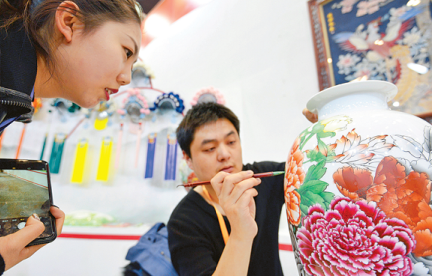Fun designs promote native culture, history

Hou Wenjie, a craftsman from the city of Changzhi, decorates a porcelain vase during a cultural expo held in Shanxi province. [Photo by Wang Ruirui for China Daily]
During the past summer holiday, the Shanxi Museum in the Shanxi provincial capital of Taiyuan gained huge popularity among tourists with its creative cultural product-popsicles in the shape of the bird-shaped bronze wine vessel.
The bronze wine vessel, also known as zun in China, was unearthed from a cemetery in the Western Zhou Dynasty (c.11th century-771 BC). It is the centerpiece of the Shanxi Museum.
"Our popsicles are tasty, beautiful, and especially meaningful. That's why I figured they would become an instant hit," said Zhang Lei, a representative of the museum's operation team.
The sweet frozen treat comes in golden mango and green matcha flavors, reflecting the two colors of bronzes when they were just produced and after being buried for thousands of years, Zhang said.
"We want to utilize the simple and interesting product, helping more people to learn about Shanxi's culture and history in a more direct way," he said.
It's not the first time that an attractive cultural product was inspired by the province's deep cultural roots.
Several years ago, Xiao You, an owl-shaped bronze container from the Shang Dynasty (c.16th century-11th century BC), received much attention online because of its stunning resemblance to the character in the mobile game Angry Birds. Chinese netizens described it as "the most lovely and trendy relic".
Shanxi then released an array of creative cultural products based on Xiao You including stationery, toys, and mystery boxes, which earned wide recognition from consumers.
Local paper-cutting master Wen Tao has been committed to improving her techniques and developing more cultural goods from her works.
While selling the products via livestreaming platforms, she taught viewers some paper-cutting skills to further promote the traditional folk art.
These relics and artworks that were once only displayed in exhibition halls have facilitated closer relationships with ordinary people through these cultural products, local officials said.
"Shanxi boasts abundant cultural and historical resources. Based on the evolving technologies, there are multiple and various cultural products we can make in the future," said Yu Man, general manager of Shanxi Xitang Culture Communication.
The company has rolled out more than 2,600 creative cultural products so far, covering Shanxi's natural scenery, historical relics and local customs, Yu said.
In September, the province launched a cultural and creative product alliance to further integrate resources and boost the local culture industry.
The alliance plans to step up cooperation with enterprises, universities, and research institutions to foster new business models in the industry.
Dong Lingyue, head of the Shanxi Cultural Relics and Museum Industry Group, said Shanxi's rich historical and cultural resources offer a considerable advantage and serve as the strongest foundation of its cultural creativity industry.
"We are confident that the industry will be more thriving and prosperous," Yu said.
Wu Jia contributed to this story.



